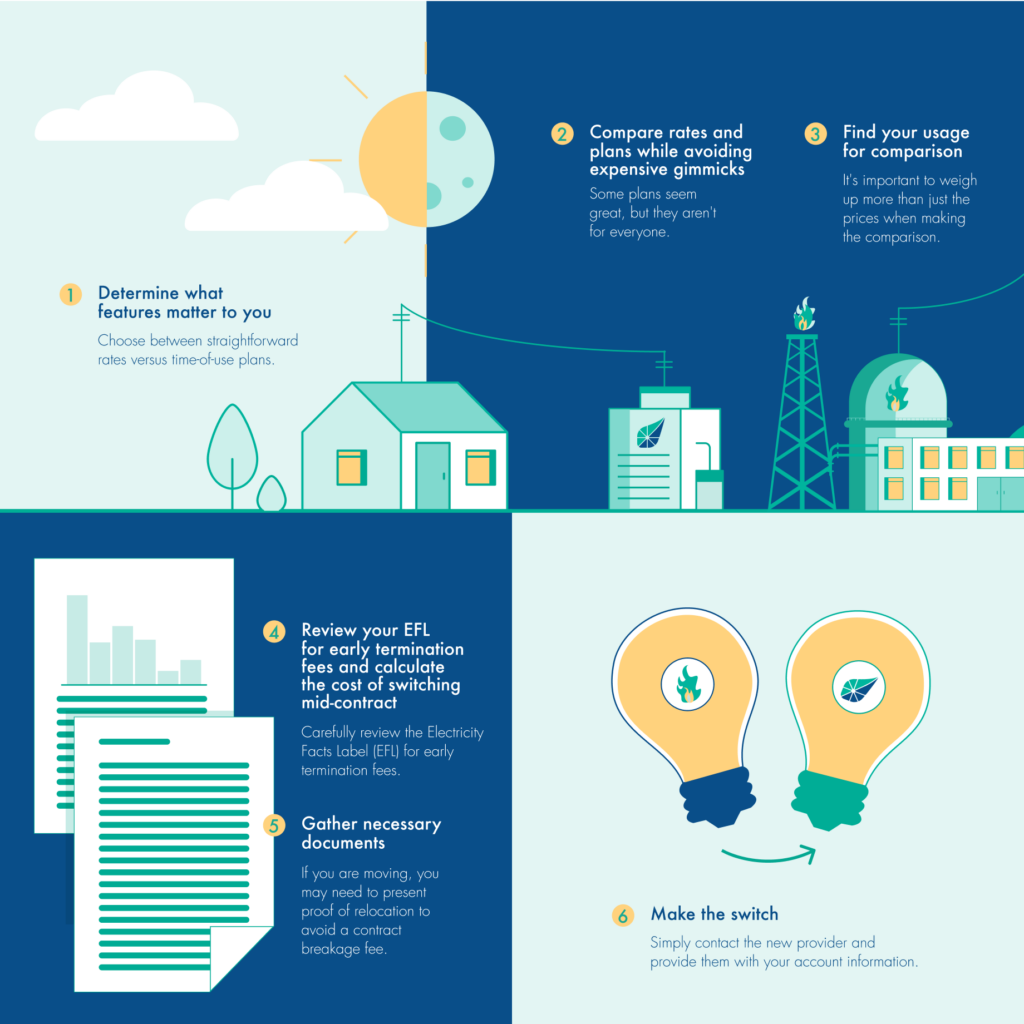Environmental Impacts of Coal
5 minute readCoal energy has powered industries for decades, but its environmental impact raises serious concerns
Home > Learning Center > How the Energy Industry Works > How to Switch Electricity Providers in Texas
8 minute read • Last update May 2025

Are you trying to save money on your energy bills, moving to a new home, or hoping to do your bit for the environment by switching electricity companies?
The good news is that in Texas, you can change your electric company at any time.
Explore BKV Energy’s affordable plans by entering your zip code below:
Switching energy providers can feel like a daunting process (and let’s be honest, there is some paperwork and planning involved).
Luckily, the cost savings and benefits can make the entire process worth your while.

Before you begin your search for a new energy provider, it’s important to determine what features matter most to you.
For example, you’ll have the option to choose between simple fixed rates and time-of-use plans.
| Simple fixed-rate plans | Time-of-use plans |
|---|---|
| Simple fixed rates are electricity pricing plans where the rate per kilowatt-hour (kWh) of electricity remains the same regardless of the time of day. In other words, the price you pay for electricity is constant, and you are charged the same rate for each unit of electricity you use. These plans are the easiest to understand and don’t require customers to meet specific usage requirements in order to get a good rate. | Time-of-use plans offer different rates for electricity consumption based on the time of day. You often pay more per kWh during peak demand and less during off-peak demand. If you consume electricity during peak hours, you will pay more per kWh than during off-peak hours. The advertised average price appears lower, but it is difficult to shift a majority of your usage to off-peak hours and bills can end up much higher than you’d expect. |
You should also consider these factors before making a decision:
Common gimmicks to watch out for include:
Many providers try to lure customers in with promotions, like free nights or weekends, low introductory rates that increase after a certain period, or plans with high usage thresholds.
On the surface, these plans seem great, but they aren’t for everyone.
Pay close attention to the Electricity Facts Label (EFL) to understand what the company means by “free” and whether or not you’ll benefit from the incentive.
If you have trouble making sense of it all, speak to a knowledgeable provider, like BKV Energy.
Our customer service team can evaluate your current bill, talk you through the ins and outs of various plans, and provide an honest assessment of our plans to help you find the best rates and plans according to your lifestyle.
You’ll need to do your research by examining your current electric bill and rate, and comparing it to the cost of the new energy supplier.
This will help you determine which plans will be the most cost-effective for your needs.
When reviewing the details of a plan, be sure to carefully review the Electricity Facts Label (EFL) for early termination fees.
If you switch to a new energy provider before your contract is up, you may be subject to an early termination fee. Calculate the cost of switching mid-contract to determine whether it’s worth it to make the switch. Long-term cost savings may make up for the initial penalty.
In most cases, no documents are required to switch energy providers. If you are moving, you may need to present proof of relocation to avoid a contract breakage fee.
It’s a good idea to have proof of identification ready in case you are asked to verify your identity.
Once you’ve selected a new energy provider, the process to make the switch is very simple.
Your new provider will handle the rest of the process, including notifying your current provider and arranging for the switch to take place.
That’s it! After completing these steps, you will have successfully switched to a new energy provider in Texas.
Yes, thanks to the deregulated energy market, consumers in Texas have the power to choose their electricity provider.
Switching energy at an established address is a very quick process. The switch typically takes around 3-7 business days to complete, but it can take up to 2-4 weeks in some cases, such as when a new meter has to be installed.
Yes, consumers in Texas can switch electricity suppliers at any time. However, you may incur fees or penalties.
Switching electric providers in Texas is relatively easy and can be done online or over the phone in a few simple steps. If you’re under a current contract with a provider, you will usually be responsible for any early termination fees when switching, unless you are moving.
To switch electric companies in Texas, you need to compare plans and rates, select a new provider, and then contact them to start the switch. Be sure your contract has ended or you’ve accounted for early termination fees in your total costs. If you’re moving to a new address, you can see if your provider has service there or you can exit your contract without early termination fees.
In Texas’s deregulated electricity market, customers can switch their REP (retail electricity provider) at any time. However, the utilities that own and maintain the grid own large patches of it, so your utility carrier will not change unless you move out of its territory.
Switching electricity providers can be a game-changer for customers who are unhappy with their current provider or want to save money on their energy bills.
In Texas, residents have the power to choose their electricity provider thanks to the state’s deregulated energy market. This means that consumers have the freedom to shop around and choose the provider that best meets their needs based on factors such as price, renewable energy options, and customer service.
First, it’s important to understand that in Texas, the electricity network is served by several different groups and partners. Your bill will contain charges from both your retail electricity provider (REP) and your local utility company, or TDU.
| Residential electricity provider (REP) | Transmission and distribution utility (TDU) | |
|---|---|---|
| Function | Purchasing wholesale electricity from power plants across the state, selling electricity to customers, and handling billing | Delivering power to homes and businesses, responsible for the maintenance and management of energy infrastructure (power lines, transformers, etc.) |
| Can you switch? | You can switch REPs whenever you want, but you may have to pay an early termination fee | You cannot switch TDUs unless you are moving to a different service region |
| How do they charge you? | Energy Charge in cents per kWh | Delivery Charge in cents per kWh and a flat monthly fee |
Is switching electricity companies worth it? Whether or not it’s worth switching providers will depend on the needs of your household.
| Pros of switching providers | Cons of switching providers |
|---|---|
| Get a cheaper rate and save money | May be required to pay an early termination fee |
| Escape a gimmicky plan with hidden fees | Electricity shopping can be a stressful task |
| Get more reliable customer service | Many electricity shopping websites are designed to confuse you |
| Switch to a plan with better benefits | Switching at the wrong time can cost you (like over the summer) |
| No interruption to your home’s power | It’s easy to fall into misleading plans |
Bear in mind that even a small savings on your energy charge will add up quickly over the year, so comparing providers is always a useful exercise.
Of course, there are other benefits to switching providers aside from cost savings.
One of the most significant reasons why consumers consider switching to electricity companies is to obtain better service. While utility companies (also known as transmission and distribution utilities, or TDUs) are responsible for delivering electricity, retail energy providers manage the customer experience.
A new energy company could provide better customer service and more reliable billing. Do your research and read reviews before making a switch. Does the provider you are considering have a good reputation for responsiveness and helpfulness? Are they willing to assist you when you’re experiencing a financial crisis?
Some providers, like BKV Energy, prioritize customer service and offer assistance through email, phone, chat, SMS, and even social media to support their customers; others are far more hands-off, and some even charge for access to customer support!
The most common reasons to switch electricity providers are:
If you’re ready to switch for any of the above reasons, make sure that you understand the basics of electricity plan shopping, such as:
It can often be a good idea to move to a different energy company, but not always.
If you’re currently locked into a contract with your energy provider, it might make more sense to wait until the contract ends to avoid breakage fees. You can also save money by switching during the off-season (spring and fall) when demand is down and rates are lower.
Securing a contract in the off-season for either 12 or 18 months ensures that when your contract ends and it’s time to pick another plan, you’re not starting over in the expensive peak seasons of summer and winter.
Ready to make the switch? Consider these tips for a smooth transition:
After you switch electric providers…
If you have questions or concerns, contact your new provider’s customer service department for assistance.

Switching electric companies in Texas is easier than you may think. Sure, it requires a little research and shopping around to find the best possible provider, but the money you can save on your bill every month (and the peace of mind you’ll have knowing you have a supplier that is always ready to assist you) will make the entire process worth your while.
If you are interested in changing electricity providers, get in touch with BKV Energy. There are no hidden fees, no vague terms, no rate surprises, and no gimmicks. Just honest, reliable energy at affordable rates.
Graham Lumley, Digital Marketing Manager at BKV Energy, leads digital and traditional marketing strategies, focusing on educating Texans about the state's deregulated energy market. With over 8 years of marketing experience, he creates content to help consumers understand and save on their energy bills, bringing a fresh and dynamic approach to the industry.

Coal energy has powered industries for decades, but its environmental impact raises serious concerns

Bill credit plans may look tempting, but for most Texans, they’re not the smartest way to save. Opting for a simple fixed-rate electricity plan often leads to lower, more predictable bills. Enter your zip code to explore more affordable Texas home electricity. What are bill credit plans? These electricity plans…
Get $50 off your electric bill!
Use code BKVEJOINUS50
Enter your zip code to shop BKV Energy's affordable, fixed-rate Texas electricity plans. Use the promo code for $50 off your electric bill.